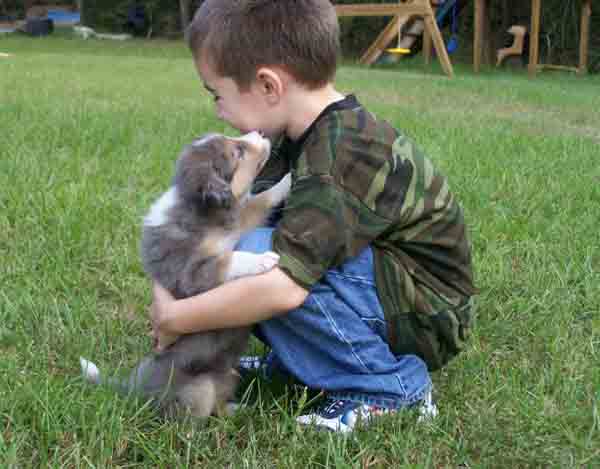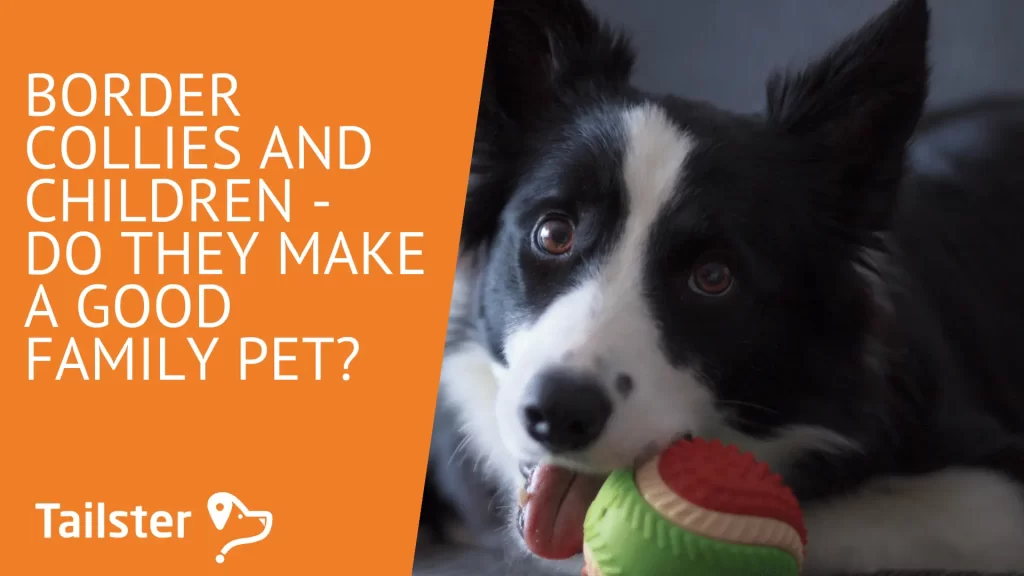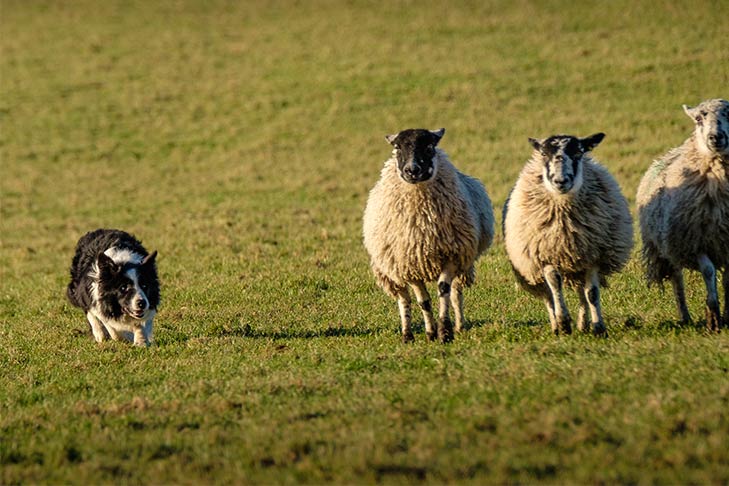Have you ever noticed that Border Collies have a tendency to herd children? It’s quite a fascinating behavior, isn’t it? You may be wondering why this breed in particular exhibits this herding instinct, and what it means for your own children. Well, in this article, we’re going to dive into the world of Border Collies and unravel the reasons behind this unique behavior. You’ll discover how it stems from their ancestry as working dogs and how it can actually be a positive trait when properly managed. So, let’s explore why Border Collies tend to herd children and what you can do to ensure a harmonious relationship between your furry friend and your little ones.
It all comes down to their innate instincts. Border Collies were originally bred for herding livestock, so it’s only natural for them to transfer that behavior onto children. Their strong herding instinct is deeply ingrained in their DNA, and they simply can’t help but react to certain movements, especially those that resemble livestock. This is why you may notice your Border Collie trying to corral your children in a playful manner. However, it’s important to remember that herding behavior can be misinterpreted as aggression or dominance, especially if your dog becomes overly possessive or starts nipping at your children’s heels. In the next paragraphs, we’ll discuss effective strategies for managing this behavior and ensuring a safe environment for both your Border Collie and your children. So, stay tuned for more insightful information on this fascinating topic!

Introduction
If you have a border collie as a family pet, you may have noticed a peculiar behavior when it comes to your children. Border collies, known for their intelligence and herding abilities, often exhibit herding behavior towards children. This can be surprising and even concerning for some parents, but understanding the reasons behind this behavior can help you manage it effectively and ensure a harmonious relationship between your pup and your little ones. In this article, we will delve into the characteristics of border collies, the instinctual herding behavior they possess, the factors that influence this behavior, and the benefits and challenges associated with it.
Characteristics of Border Collies
High energy levels
Border collies are known for their boundless energy. They are a working breed that thrives on physical and mental stimulation. This high energy level is a result of their herding background, as they were bred to work tirelessly on farms. It’s important to understand that border collies require plenty of exercise to stay happy and healthy. When they don’t get the physical activity they need, they may find other outlets for their energy, such as herding behavior towards children.
Intelligence and trainability
Border collies are widely recognized as one of the most intelligent dog breeds. Their problem-solving abilities and quick learning make them an excellent choice for various tasks, including herding livestock. However, this intelligence can also create challenges when it comes to managing their herding behavior towards children. They may perceive the children as a part of their “flock” and feel the need to control their movements.
Instinctual herding behavior
Herding is an innate instinct in border collies. Historically, they were bred to work alongside shepherds in guiding and controlling livestock. This instinct drives them to gather, chase, and control the movement of animals. When a border collie exhibits herding behavior towards children, it is a sign that their natural instincts are being triggered. Understanding the root of this behavior is crucial in addressing it effectively.
Understanding Herding Behavior
Herding instinct in dogs
Herding instinct is a natural trait present in many dog breeds. It involves a strong desire to gather and control the movements of a group, typically livestock or other animals. While not all dogs exhibit herding behavior, certain breeds are more prone to it due to their breeding history. Border collies, being working dogs with a strong herding background, are among the breeds most likely to display this behavior.
Herding drive in Border Collies
Border collies have an innate drive to herd. They possess a strong instinctual desire to gather and move objects or individuals, mimicking their herding behavior with livestock. When this instinct is triggered by the presence of children, border collies may exhibit herding behaviors such as nudging, circling, barking, or even nipping. It’s essential to understand that these behaviors are not aggressive in nature but rather an expression of their natural instinct.
Herding behavior towards children
When border collies exhibit herding behaviors towards children, it’s important to remember that they are not intentionally trying to harm the kids. Instead, they see them as part of their “flock” and feel the need to guide and control their movements. This behavior can manifest in different ways, including nudging, circling, barking, and nipping. While it may seem concerning, it’s crucial to manage this behavior effectively to ensure the safety and well-being of both your pet and your children.
Factors Influencing Herding Behavior
Breed genetics
The herding behavior in border collies is deeply rooted in their genetics. Over generations of breeding for herding traits, these instincts have become ingrained in their DNA. It’s vital to recognize that your border collie’s herding behavior towards children is not a result of poor training or socialization but rather a natural trait that they possess. Understanding their genetic predisposition can help you approach their behavior with empathy and appropriate training techniques.
Socialization and training
While breed genetics play a significant role in a border collie’s herding instincts, proper socialization and training can help manage and shape their behavior. Early socialization is crucial in exposing border collies to different people, places, and situations, including interactions with children. Positive experiences during this critical period can help them develop a well-rounded and appropriate response to children’s presence, reducing the likelihood of excessive herding behaviors.
Environmental factors
Environmental factors can also influence a border collie’s herding behavior towards children. A lack of exposure to children during their formative years or limited social interactions can cause them to perceive children as novel and unfamiliar objects to be herded. Additionally, inconsistent or incorrect responses to herding behaviors can inadvertently reinforce this behavior. Creating a positive and consistent environment for your border collie can help them understand appropriate boundaries and behaviors around children.

Herding Behavior Manifestations
Nudging and circling
One of the most common herding behaviors displayed by border collies towards children is nudging and circling. When your border collie nudges your child, it may be an attempt to guide them or maintain control over their movements. Circling is another behavior where the dog moves in circles around the child, mimicking their herding behavior with livestock. It’s essential to monitor these behaviors, as they can escalate if not managed appropriately.
Barking and nipping
In some instances, border collies may express their herding instinct through barking and nipping. While it’s crucial to understand that these behaviors are not aggressive in nature, they can be alarming and potentially harmful to children. Barking serves as a way for the border collie to communicate and exert control, while nipping may be an attempt to mimic the nips used on livestock during herding. It’s essential to address these behaviors promptly and redirect them towards appropriate alternatives.
Controlling movements
Border collies may also exhibit controlling behaviors when herding children. This can include physically blocking their path, cutting off their movements, or even herding them to a desired location. While these actions may seem excessive or concerning, it’s important to remember that border collies are acting on their natural instincts and perceiving the children as part of their flock.
Benefits of Herding Behavior
Protective instincts
One of the benefits of border collies exhibiting herding behavior towards children is their inherent protective instincts. They see the children as part of their flock and feel a strong sense of responsibility for their well-being. This protective nature can be comforting for parents, as they know their border collie will go to great lengths to ensure the safety of their little ones.
Sense of purpose and fulfillment
Herding behavior allows border collies to have a sense of purpose and fulfillment. Through herding, they are fulfilling their innate instincts and engaging in an activity that they excel at. It provides mental stimulation and physical exercise, which are crucial for their overall well-being. When managed appropriately, allowing your border collie to express their herding behavior in controlled settings can contribute to their overall happiness and contentment.
Building a strong bond with children
When managed effectively, herding behavior can create a strong bond between border collies and children. As the dog fulfills their natural instinct to control and guide, they develop a sense of responsibility and affection towards the children. This bond can be mutually beneficial, as both the border collie and the child form a deeper connection built on trust and understanding.

Challenges of Herding Behavior
Safety concerns
While herding behavior can have its benefits, safety concerns are undoubtedly one of the primary challenges associated with it. Border collies, in their attempt to control movements, may unintentionally cause accidents, such as tripping or knocking over a child. It’s crucial to supervise interactions between your border collie and your children to prevent any harm or injuries.
Potential for accidental injury
Some of the behaviors associated with herding, such as nipping, can potentially lead to accidental injuries. While border collies generally use gentle nips when herding livestock, this behavior may not be suitable or appropriate when directed towards children. It’s essential to address and redirect this behavior through positive reinforcement training techniques to prevent any accidental harm caused to your child.
Misinterpreting children’s behavior
Border collies may misinterpret certain behaviors from children, leading to heightened herding responses. For example, fast movements or high-pitched voices may trigger their herding instincts. It’s important to educate your children about appropriate behavior around your border collie to minimize any miscommunications or escalating herding behaviors.
Managing Herding Behavior
Proper socialization and training
One of the key ways to manage herding behavior in border collies is through proper socialization and training. Starting from a young age, expose your border collie to different environments, people, and situations, ensuring positive interactions with children. This will help them develop appropriate responses and limit excessive herding behaviors. Enroll in obedience training classes that focus on positive reinforcement techniques to establish clear boundaries and reinforce desired behaviors.
Redirecting and channeling behavior
When your border collie exhibits herding behaviors towards children, it’s important to redirect their attention and provide appropriate outlets for their energy. Engaging them in mentally stimulating activities, such as puzzle toys or scent games, can divert their focus and provide an alternative to herding behaviors. Channeling their energy into constructive activities is key in managing their herding instincts effectively.
Creating boundaries
Establishing clear boundaries for your border collie is crucial in managing their herding behavior. Teach them the “leave it” or “settle” commands to interrupt herding behaviors and redirect their attention. Use physical barriers, such as baby gates or playpens, to create separation when necessary. Consistency and positive reinforcement are key in ensuring that your border collie understands when their herding behavior is appropriate and when it should be discouraged.

Positive Reinforcement Techniques
Reward-based training
Positive reinforcement techniques involve rewarding desired behaviors to encourage their repetition. When managing herding behavior in border collies, it’s important to focus on rewarding alternative behaviors and redirecting their attention away from herding. Treats, praise, and affection can serve as powerful motivators for your border collie and reinforce appropriate responses around children.
Using toys and treats
Equipping your border collie with appropriate toys and treats can help redirect their herding instincts. Interactive toys, such as puzzle toys or treat-dispensing toys, engage their minds and provide physical exercise. Use these toys as a distraction and reward after appropriate behaviors, diverting their attention away from herding behaviors towards children.
Clicker training
Clicker training is a popular positive reinforcement technique that involves using a clicker to mark desired behaviors, followed by a reward. By associating the sound of the clicker with a reward, you can communicate to your border collie when they have performed an appropriate behavior. Consistent use of the clicker and reward system can help shape their behavior and reinforce appropriate responses around children.
Understanding Children’s Role
Respecting boundaries
Teaching your children to respect boundaries and behave appropriately around your border collie is essential in managing herding behavior. Teach them to move calmly and avoid sudden movements that may trigger the dog’s herding instincts. Encourage your children to interact with the border collie in a gentle and respectful manner, avoiding any rough play or teasing.
Avoiding triggering behaviors
Educating your children about behaviors that may trigger the dog’s herding instincts can help prevent excessive herding responses. Teach them to avoid running or screaming around your border collie, as these behaviors are likely to be misinterpreted as a cue to start herding. By understanding how their actions can influence the dog’s behavior, your children can play an active role in managing and minimizing herding behaviors.
Encouraging positive interactions
While it’s important to manage herding behaviors, it’s equally crucial to encourage positive interactions between your border collie and your children. Supervised play sessions that involve gentle petting and interactive games can help foster a strong bond between the two. By reinforcing positive interactions, you can promote a harmonious relationship and a sense of trust.
Addressing Herding Behavior Issues
Seeking professional help
If you find that your border collie’s herding behavior towards children is difficult to manage on your own, it may be beneficial to seek professional help. Dog trainers or behaviorists experienced in working with herding breeds can provide guidance and specialized training techniques to address and modify these behaviors. They can assess your specific situation and offer tailored advice to ensure the safety and well-being of both your dog and your children.
Behavior modification techniques
Behavior modification techniques can be effective in addressing and managing herding behavior in border collies. These techniques focus on redirecting the dog’s energy and reinforcing alternative behaviors. With the help of a professional, you can develop a customized behavior modification plan that incorporates positive reinforcement training, environmental management, and desensitization exercises.
Creating a calm environment
Creating a calm and structured environment is essential in managing herding behavior. Establish consistent routines for your border collie, including designated times for exercise and mental stimulation. Providing them with a quiet and safe space where they can retreat and relax can help reduce anxiety and excessive herding behaviors. Applying techniques such as crate training and implementing calming activities can contribute to a peaceful living environment.
Impact on Children
Educational and learning experiences
Growing up with a border collie that exhibits herding behavior can provide unique educational and learning experiences for children. They can witness firsthand a dog’s natural instincts and learn about the breed’s history and purpose. By understanding why the dog engages in herding behaviors, children can develop empathy and knowledge about animal behavior.
Development of empathy and responsibility
Interacting with a border collie that exhibits herding behavior can promote the development of empathy and responsibility in children. They learn to understand and respect the dog’s needs and boundaries, while also recognizing the impact of their own behaviors. By nurturing a compassionate and responsible attitude towards animals, children can apply these skills to various aspects of their lives.
Bonding with pets
Despite the challenges associated with herding behavior, the bond formed between children and their border collie can be incredibly strong. As they navigate through managing and understanding the dog’s herding instincts, children develop a special connection built on trust, communication, and cooperation. This bond can contribute to a positive and lasting relationship that extends beyond childhood.
Conclusion
Understanding why border collies tend to herd children is key to effectively managing this behavior and ensuring a safe and harmonious relationship between your dog and your little ones. Recognizing the breed’s characteristics, their herding instincts, and the factors that influence this behavior provides valuable insights into how you can address and redirect their energy. By implementing appropriate training techniques, creating clear boundaries, and encouraging positive interactions, you can promote a positive environment for both your border collie and your children. Embracing the unique bond that can form between children and their herding dog can lead to educational experiences, the development of empathy and responsibility, and a lifelong friendship.
